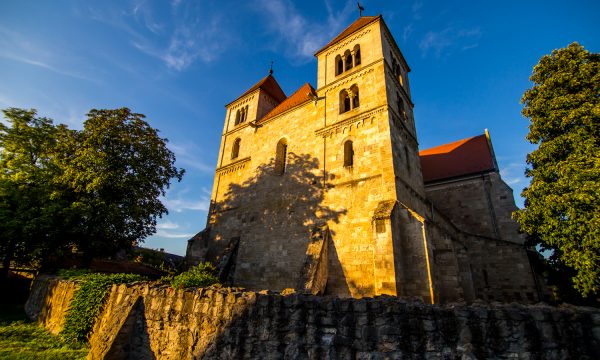As the Norbertine order only founded monasteries around populated areas, we can assume that Ócsa was an inhabited village already before the construction of the monastery. In the old place of the church, set on a hill rising from the floodplain of the Danube, in-ground houses formed a village enisled with a hedge.

It was probably either Andrew II or one of his courtiers who invited the monks, gave them properties together with the order to build a monumental stone church, which was most probably standing before 1234. One of the distinctive features of the building is that a transept is connected to the three-nave church. The two branches of the transept have apses attached to them on the east. The main shrine is both wider and longer with a quadrant than these. This extra quadrant was the place of the monks. Although there were thick pillars inside the nave, and the walls were fortified with counterforts, only the shrine quadrant and the apses were vaulted. The style of the carvings on the gates and the capstones show the influence of the early gothic constructions of the royal court (see for example the carvings from Pilisszentkerest and Kalocsa). The monks ran away under the Ottoman conquest, but the village did not depopulate. In 1560 the population of the village was Calvinist. They used the old abandoned church, but only its shrine, which they walled off, given the edifice’s monumental proportions. All the other, unused parts of the church started to deteriorate. Their renovations were only finished by 1777. Further restorations were carried out in 1897 and the tower was also renewed between 1922–1924. The catholic church was built in 1774. Ócsa has kept for a long time its double-plot structure, specific for the livestock-breeding villages of the Great Hungarian Plain. The stables stood in the surroundings of the village and not close to the houses. It is essential to mention the houses surrounding the church, known as the ‘old village’, the over 500 carved funeral posts (Hu: kopjafa) of the old Reformed cemetery and the cellars of the Old Mountain (Hu: Öreg-hegy) as the spectacular relics of vernacular architecture.
Based on the artefacts discovered near the church, the area was populated by Celts around 300 BC. North from the church they managed to explore and open up the abbey, consisting of one building. The chapter house and the refectory were located at the ground floor of the elongated, rectangle shaped convent. A stairway starting up from the ground floor indicates that the dormitories were most probably located upstairs. A wall starting from the western facade in northern direction connected the monastery with the church. Its cloister – even if there was one – had to be made of wood, because we have no evidence or trace of it. In the vineyards of the Old Mountain relics belonging to the Vatya culture from the bronze age, 1600 BC were revealed.
